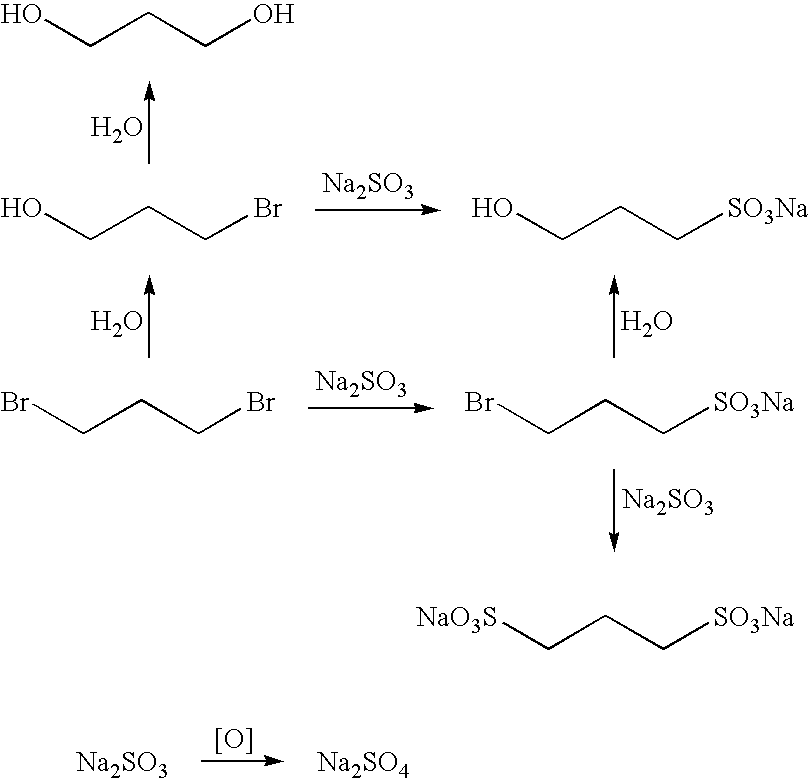Pharmaceutical drug candidates and methods for preparation thereof
- Summary
- Abstract
- Description
- Claims
- Application Information
AI Technical Summary
Benefits of technology
Problems solved by technology
Method used
Image
Examples
example 1
Large Scale Synthesis of 1,3-propanedisulfonic acid disodium salt
[0421] To degassed water (550 mL) under a nitrogen atmosphere sodium sulfite (150 g. 1.19 mol) was loaded in one-portion. The mixture was stirred for 10 min. at room temperature. (In fact, effective stirring was applied throughout the entire reaction process.) After the dissolution of the sodium sulfite, the mixture was cooled to around 10° C. (internal temperature). To the cooled mixture was added a solution of 1,3-propane sultone (155 g, 1.27 mol) in acetone (100 mL) dropwise, or through a cannula over a 60-min. period. The rate of the addition was adjusted to maintain the internal temperature below 15° C.
[0422] The internal temperature was kept at a temperature below 15° C. for 15 min. after the completion of the addition, and then warmed to 15° C. The mixture was then stirred for 3 h at 15° C. The mixture was subsequently cooled to an internal temperature of 10° C. To the cold, stirred mixture, absolute ethanol (...
example 2
Production Scale Synthesis of 1,3-propanedisulfonic acid disodium salt
[0425] To degassed water (550 kg) under a nitrogen atmosphere, sodium sulfite (150 kg) is loaded in one-portion. The mixture is then stirred for 30 min. at room temperature. Heating is applied if necessary to speed up the dissolution of the sodium sulfite. (Effective stirring is applied throughout the entire reaction process.) After the dissolution of the sodium sulfite, the mixture is cooled to around 10° C. (internal temperature). To the cooled mixture a solution of 1,3-propane sultone (155 kg) in acetone (100 L) is added over a 2 h period. The rate of the addition is adjusted to maintain the internal temperature below 15° C.
[0426] The internal temperature is kept at a temperature that is below 15° C. for 1 h after the completion of the addition, and then warmed to 15° C. The mixture is stirred for 3 to 5 h at 15° C., cooled to an internal temperature of 10° C., and absolute ethanol (900 kg) is added to the co...
example 3
[0477] The ability of a sulfonate derivatized compound of the invention to inhibit an interaction between an amyloidogenic protein and a glycoprotein or proteoglycan constituent of a basement membrane can be used to assess the pharmaceutical applicability of the compounds. In particular, the binding of a sulfonate derivatized compound of the invention to amyloid fibrils may be measured using a mass spectroscopy (“MS”) assays as described herein below. The resulting MS assay data provides insight into the ability of compounds to bind to Aβ.
[0478] Samples are prepared as aqueous solutions containing 20% ethanol, 200 βM of a test compound and 20 μM of solubilized Aβ40. The pH value of each sample is adjusted to 7.4 (±0.2) by addition of 0.1% aqueous sodium hydroxide. The solutions are then analyzed by electrospray ionization mass spectroscopy using a Waters ZQ 4000 mass spectrometer. Samples are introduced by direct infusion at a flow-rate of 25 μL / min within 2...
PUM
| Property | Measurement | Unit |
|---|---|---|
| Fraction | aaaaa | aaaaa |
| Fraction | aaaaa | aaaaa |
| Fraction | aaaaa | aaaaa |
Abstract
Description
Claims
Application Information
 Login to View More
Login to View More - R&D Engineer
- R&D Manager
- IP Professional
- Industry Leading Data Capabilities
- Powerful AI technology
- Patent DNA Extraction
Browse by: Latest US Patents, China's latest patents, Technical Efficacy Thesaurus, Application Domain, Technology Topic, Popular Technical Reports.
© 2024 PatSnap. All rights reserved.Legal|Privacy policy|Modern Slavery Act Transparency Statement|Sitemap|About US| Contact US: help@patsnap.com










